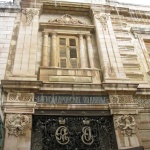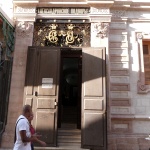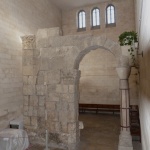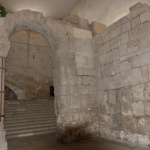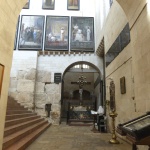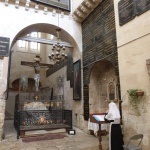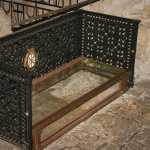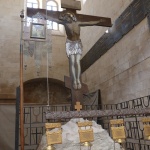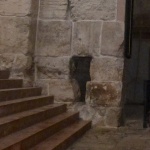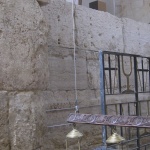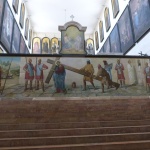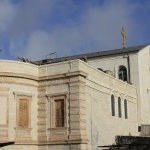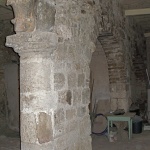Jerusalem
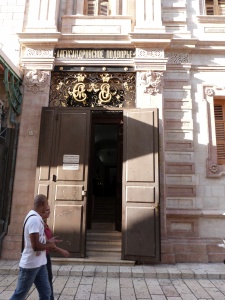
Solid security doors at entrance to the Church of St Alexander Nevsky (Seetheholyland.net)
Remnants of the emperor Constantine’s original 4th-century Holy Sepulchre church can be seen inside a Russian Orthodox church that is a next-door neighbour of the present Church of the Holy Sepulchre.
The Church of St Alexander Nevsky — named after a 13th-century Russian warrior-prince — is often overlooked because its façade resembles an elegant residence or hotel rather than a church.
The tall and narrow façade, with solid security doors bearing notices in Russian, is at 25 Souq al-Dabbagha, about 70 metres from the entrance to the Holy Sepulchre courtyard.
Excavations here in 1883 — before the church was built — attracted worldwide attention, leading to the site becoming known as the “Russian Excavations”.
Particular attention focused on the discovery of a gate threshold believed by the excavators to belong to the Judgement Gate by which Jesus left the city on the way to the hill of Calvary (now contained within the Holy Sepulchre church). Modern archaeologists consider the gate probably dates from the 2nd century.
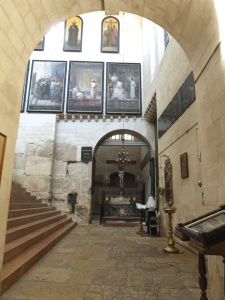
Reconstructed stairs on left led to Constantine’s Holy Sepulchre church (Seetheholyland.net)
The excavators also uncovered remains of the easternmost parts of Constantine’s 4th-century church, including the wide staircase that led to the church entrance.
As New Testament scholar Jerome Murphy-O’Connor put it, what was found “corresponds exactly to the eastern end of the Constantinian Holy Sepulchre as depicted in the sixth-century Madaba Map”.
Historical remains halted construction
The site on which the Church of St Alexander Nevsky stands was purchased in 1857 by the Imperial Orthodox Palestine Society, a lay organisation founded to assist faithful of the Russian Orthodox Church in the Holy Land.
The idea was to build a Russian consulate and a hostel for pilgrims, who were arriving in their thousands at the port of Jaffa and often walking the 70 kilometres to Jerusalem.
When workers digging the foundations uncovered historical remains, construction was halted. Eventually the consulate and hostel were built outside the Old City, at a site now known as the Russian Compound, and a church was built over the ruins in Souq al-Dabbagha.
Because the excavations and the church were funded by the Grand Duke Sergei Alexandrovich, the property gained the popular name of the “Alexander Hospice”.
Stairway led to Holy Sepulchre church
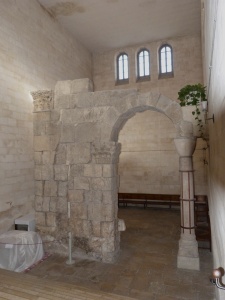
Archway leading to excavated area of Church of St Alexander Nevsky (Seetheholyland.net)
Entering the excavated area in the basement of the church, one descends stairs to an archway. The right-hand column is from the 11th century; the stonework on the left is part of an entrance to the main forum established by the emperor Hadrian when he rebuilt Jerusalem as a Roman colony in the 2nd century.
Descending through the arch and turning left, one sees on the left a reconstruction of the wide stairway that led to the original Church of the Holy Sepulchre — which was much bigger than the present basilica.
Straight ahead, under a glass covering, is the gate threshold once thought to have been where Jesus left the city on the way to Calvary. This threshold may have been part of an arch built by Hadrian, but it was later re-used as an entrance to the Holy Sepulchre.
Next to the threshold is a large piece of the rock of Calvary, purchased when the church was built. Above it a crucifix has been fixed.
In the Roman wall to the left is an opening called the Eye of the Needle, intended for travellers who arrived after the gate was closed for the night.
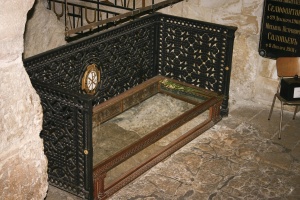
“Judgement Gate” threshold displayed under glass (© Stanislao Lee / Custodia Terrae Sanctae)
On the other side of the threshold are the remains of another entrance to the Holy Sepulchre, cut into a Roman wall by Constantine’s engineers.
(Further massive remnants of the main entrance to the Holy Sepulchre could once be visited in the adjoining property of Zalatimo’s sweetshop on Souq Khan al-Zeit, but this is now closed.)
Chapel dedication honours medieval leader
At the top of the wide stairway is a sweeping depiction of Jesus carrying his cross. Behind it is a chapel, accessible from the ground floor.
Icon of St Alexander Nevsky from the cathedral in Sofia, Bulgaria, that bears his name (Vassia Atanassova / Wikimedia)
The iconostasis, decorated in black and gold, dominates the chapel. Around the walls are hung paintings of Gospel scenes and, above these, a series of icons of Russian Orthodox saints.
The dedication of the chapel to St Alexander Nevsky honoured an exceptional leader of medieval Russia, who was accorded legendary status for his military victories over German and Swedish invaders. He was proclaimed a saint of the Russian Orthodox Church in 1547.
Administered by: Imperial Russian Orthodox Palestine Society
Tel.: 02-627-4952
Open: 9am-6pm
- Frontage of Church of St Alexander Nevsky (© Deror Avi)
- Solid security doors at entrance to the Church of St Alexander Nevsky (Seetheholyland.net)
- Archway leading to excavated area of Church of St Alexander Nevsky (Seetheholyland.net)
- Stonework on right is part of Hadrian’s 2nd-century forum (Seetheholyland.net)
- Reconstructed stairs on left led to Constantine’s Holy Sepulchre church (Seetheholyland.net)
- Russian nun praying in front of “Judgement Gate” threshold (Seetheholyland.net)
- “Judgement Gate” threshold displayed under glass (© Stanislao Lee / Custodia Terrae Sanctae)
- Crucifix standing over piece of rock of Calvary (Seetheholyland.net)
- Eye of the Needle opening in Roman wall (Seetheholyland.net)
- Part of wall erected by Hadrian and re-used by Constantine for his Holy Sepulchre church (© Deror Avi)
- Depiction of Jesus carrying his cross, on top step of stairs to original Holy Sepulchre church (Seetheholyland.net)
- Iconostasis in St Alexander Nevsky chapel (Seetheholyland.net)
- Gospel scenes and icons of saints in St Alexander Nevsky chapel (Seetheholyland.net)
- Icons of saints in St Alexander Nevsky chapel (Seetheholyland.net)
- Icon of St Alexander Nevsky from the cathedral in Sofia, Bulgaria, that bears his name (Vassia Atanassova / Wikimedia)
- Exterior of Church of St Alexander Nevsky (Gabrielw.tour)
- Remains of main entrance to Constantine’s church, in the now-closed Zalatimo’s sweetshop (Seetheholyland.net)
References
Bar-Am, Aviva: Beyond the Walls: Churches of Jerusalem (Ahva Press, 1998)
Freeman-Grenville, G. S. P.: The Holy Land: A Pilgrim’s Guide to Israel, Jordan and the Sinai (Continuum Publishing, 1996)
Gonen, Rivka: Biblical Holy Places: An illustrated guide (Collier Macmillan, 1987)
Murphy-O’Connor, Jerome: Keys to Jerusalem (Oxford University Press, 2012)
Murphy-O’Connor, Jerome: The Holy Land: An Oxford Archaeological Guide from Earliest Times to 1700 (Oxford University Press, 2005)
Prag, Kay: Jerusalem: Blue Guide (A. & C. Black, 1989)
External links
Imperial Orthodox Palestine Society (Wikipedia)
Alexander Nevsky (Orthodox Wiki)

